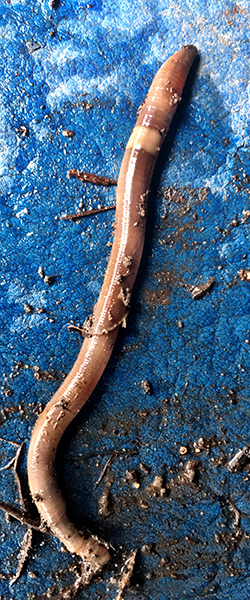Above: Jumping worm. Purdue Agricultural Communications photo
A worm getting headlines – that’s something you don’t see every day. Nevertheless, we are on the lookout for a new invasive pest in Indiana – the Asian jumping worm.
USDA reports that the invasive Asian jumping worm (Amynthas agrestis) has many common names: Alabama jumpers, Jersey wrigglers, wood eel, crazy worms, snake worms, and crazy snake worms.
While earthworms in the spring are a happy sight for gardeners, this invasive worm species is wreaking havoc for landowners and gardeners in southern Indiana, but human activity may have moved them to other locations.
Robert Bruner, Purdue Extension’s exotic forest pest specialist, describes jumping worms, an invasive species to North America in the genus Amynthas: “Traditionally, when we see earthworms, they are deep in the ground and a little slimy. The jumping worms are a little bit bigger, kind of dry and scaly, and tend to thrash around much like a snake does.”
While worms have a reputation as a helpful species found in the soil ecosystem, invasive jumping worms do not live up to that standard, Bruner explained. Jumping worms will consume all organic material from the top layer of soil, leaving behind a coffee ground-like waste with no nutrients for plants or seeds.
Since jumping worms stay within the first few inches of topsoil, they are not creating channels for water and air the way earthworms do, disrupting water flow to plant roots.
“So basically, they’re just very nasty pests that ruin the quality of our soil, and the only thing that can really grow in soil like that are essentially invasive plants, or species that are meant to survive really harsh conditions,” Bruner said.
Currently, the worms are being found in cities around southern Indiana, he said, particularly in Terre Haute. There is still much to learn about jumping worms, making eradication efforts difficult. One thing that is known, Bruner said, is they aren’t a migrating species.
“This is the kind of invasive pest that is moved almost entirely through human activity. They don’t crawl superfast,” he explained. “So, when they move, that means they’re moving because we’re transferring soil, say, from someone’s plants or someone’s compost and we’re bringing them to a new area.”
Bruner is working with fellow Purdue Extension educators to spread the message that gardeners should not share ground soil or compost and avoid potted plants from unknown sources. If you suspect jumping worms are present in your own soil, Bruner suggests a process called solarizing to eliminate unwanted pests. Gardeners should lay down a black or dark-toned tarp on a sunny day and sprinkle a thin layer of soil on top, allowing it to reach a temperature over 105 degrees Fahrenheit.
Bruner cautions that jumping worms can escape during the solarizing process, “so you need to completely wrap the soil up in the tarp, essentially making the world’s worst sandwich, and allow it to heat up and kill whatever is in there.”
Bruner said whether the worms will create a major issue for gardeners this season remains to be seen, but he isn’t as concerned for farmers.
“It’s a bit of a nightmare pest if you do gardening, but we don’t have evidence yet that it will spread into agricultural fields,” he said. “We don’t think it’s going to kill any kind of industry. We’re asking people to be on the lookout and use your best judgment when you’re getting your soil.”
Gardens aren’t the only ecosystem of concern, however, as forests are also a concern. “The worms began arriving in the early 1900s, tucked away in the soil of potted plants,” reported USDA. “But only in recent decades have these species been showing up in more natural forested ecosystems.”
According to USDA, they are considered non-native and invasive because they did not evolve alongside the species of the U.S., and because they harm other species in the ecosystem.
Find information from USDA on jumping worms at https://www.fs.usda.gov/features/invasive-jumping-worms-can-change-their-world.
Any invasive species sightings should be reported to the Indiana Department of Natural Resources at depp@dnr.in.gov or by calling 1-866-663-9684.

Above: Jumping worm. Purdue Agricultural Communications photo
Source: Robert Bruner, rfbruner@purdue.edu